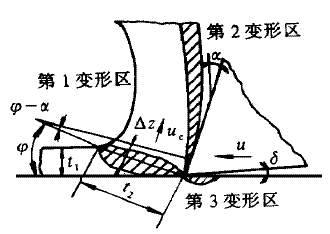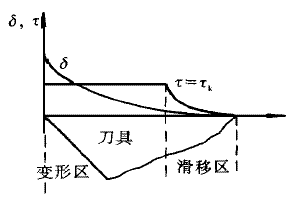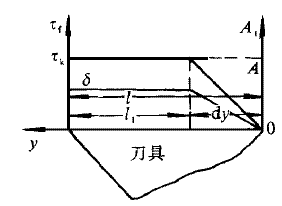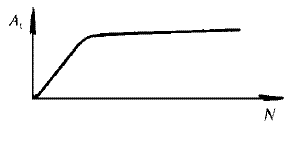Pick to objective analysis of the metal material between the friction and wear mechanism of acoustic emission signal, illustrates the degree of wear and tear and acoustic emission signal mathematical quantitative relationship. Plastic work method in describing the metal cutting process, on the basis of orthogonal cutting process, for example, this paper discusses the three plastic work power theory expression of deformation zone, and the mechanism of acoustic emission and the plastic power of the cutting process. The results are given in the process of turning the energy of the acoustic emission signal index, the mathematical model of relationship between processing conditions with the outside world. Conclusion the mathematical model for the correct identification in the process of turning tool cutting state laid a theoretical foundation.
Acoustic emission method is to study the friction and wear one of the important methods of [1], in the process of friction and wear by qualitative and quantitative monitoring of acoustic emission signal can be speculated that the size of the friction and wear. The author studied the friction between the metal material, the wear mechanism of acoustic emission signal, on the basis of the acoustic emission mechanism of cutting process are discussed in this paper, the friction and wear process is given, the mathematical model of acoustic emission signal, and the acoustic emission signal energy index of processing parameters, a mathematical model with the outside world for acoustic emission method in cutting tool condition monitoring laid a theoretical foundation for the further application.
1 metal materials of the friction and wear between acoustic emission signal model
From literature [2 ~ 6] and experiment that the acoustic emission source is a kind of material internal role due to external conditions caused by elastic wave moment of release, is detectable. The friction and wear of the acoustic emission signal in pseudo random state in a long observation time [3], is composed of an infinite number of small acoustic emission source on the time history of emergence and the combination of superposition, this not only because of the random acoustic emission signal is an infinite number of the impact of the small type of acoustic emission source, and as a result of the acoustic emission signals produced in essence is the material of the internal elastic wave caused by instantaneous release.
Mathematically it is difficult to use certain mathematical expressions to describe the acoustic emission signal model, must use statistical point of view or method to study the acoustic emission signal and the quantitative relationship between friction and wear.
By the tribology, the friction surface of the object friction stress for tau = u p (1)
Type of mu as the surface friction coefficient; P is pressure for the friction surface method.
Two objects under the condition of linear elastic material, the effective area of contact is associated with positive pressure and contact with the object, therefore, the effective contact area and the relationship between the positive pressure for A = A A0 (p/p0) n (2)
Type of A0 to contact objects not elastic deformation occurs in the contact area; N depends on the coefficient of material; P0 is required for contact objects not elastic deformation occurs pressure. Therefore, the friction between the friction surface can be expressed as
F = tau A (3)
Will type (3) into type (2)
F = mu pA0 (p/p0) (4)
Only in the friction surface of relative movement occurs, will produce friction, the friction power per unit time can be expressed as w. = Fu (5)
Type of u for friction surface relative speed.
Considering the friction between the friction surface and relative speed with a change in the physical properties between the surface and sliding force changes in the surface, type (5) each component should be a function of time, so that power can be represented as the transient friction
W. (t) = F (t) u (t) (6)
Signal the root mean square (RMS) value of signal energy, the size of the acoustic emission signal energy per unit time expressed in RMS statistical parameters for W.R MS (t) = eta F (t) u (t) (7)
Type of eta for between friction and acoustic emission energy conversion coefficient.
By literature [7], the friction and wear between the surface wear is VW and acoustic emission signal is nonlinear integral relationship between the RMS, namely the VW = alpha (t) ∫ w. beta (t) RMSdt (8)
Type of alpha and beta (t) (t) depends on the friction surface is dry friction or lubrication friction and wear degree. Type (7) into type (8) VW = alpha (t) ∫ [eta F (t) u (t)] beta (t) dt (9)
Are discussed in detail in reference [5] the alpha and beta (t) (t)) in all cases of empirical formula.
Type (9) shows that the wear is the size of its relationship with material properties and external conditions, therefore, in the known conditions and material properties on the basis of the outside world, can be made of (9) speculated that the size of the amount of wear and tear, this type is called under the mechanism of acoustic emission, the mathematical model of friction and wear of the experience.
2 metal cutting process and plastic work
Metal cutting process, the acoustic emission phenomenon was mainly caused by plastic deformation and friction and wear and fracture, including processing plastic deformation on the surface of the workpiece and cutting tool machining surface friction and wear, plastic deformation of chip, chip breaker and wound caused by friction and wear, and the tool wear and breakage. In addition to the tool breakage are sudden acoustic emission signal, the various process caused by acoustic emission signals are random signal. A random signal in time domain, V (t) said Δ t said a certain period of time, is within the time Δ t, RMS is expressed as the signal
VRMS (t) = 1 Δ t ∫ Δ T0V2 dt1 (t) / 2 (10)
And signal energy rate is proportional to the square of the RMS, namely dE/dt ∝ VRMS (t) 2 (11)
E for the signal energy in type.
For a test system, the actual signal energy should be measured signal RMST RMSn minus the background noise, namely VRMS (t) = 2 [VRMS (t) 2 t - VRMS (t) 2 n] (12)
Due to plastic deformation of material per unit volume energy increased by dW1 = ∑ sigma id epsilon I = sigma 1 d epsilon 1 = epsilon 2 = sigma sigma 2 d 3 d epsilon 3 (13)
In type 1, 2, sigma sigma sigma 3 main stress components; D epsilon 1, epsilon 2 d and 3 d epsilon strain increment; Sigma I and d epsilon for stress and strain increment tensor I said.
For unit volume dV, sigma ij effect produced by stress d epsilon ij plastic strain increment, lead to the increase of the plastic work for dW = sigma ijd epsilon ijdV (14)
Consider the volume V by the external force and produce plastic deformation rate epsilon. Ij, the plastic power of the volume V as w. = ∫ V sigma ij epsilon. Ij, dV (15)
If the material under constant stress sigma is a constant strain rate epsilon., the energy ratio of w. = sigma epsilon. V (16)
Type V as the distortion of material in the volume. Type (16) shows that the rate of acoustic emission signal energy depends on the deformation rate (strain rate epsilon), the effect of stress (sigma) and the volume of drying food materials.
Acoustic emission signal model 3 orthogonal cutting process
In the process of orthogonal cutting, cutting tool and the workpiece contact form and the terms used are shown in figure 1.

Alpha before __ Angle; Phi __ shear Angle; U - cutting speed;
Uc - chip flow speed; Us - shear rate;
T1 - not cutting thickness; T2 - chip thickness
Chip formation in deformation zone 1 and 2 in the deformation zone slip on the surface of the tool and the cutting tool knife surface and the workpiece after extrusion slip, leading to the production of the acoustic emission signal, in three areas, includes friction also
Including the plastic deformation or both at the same time.
In metal cutting process, the plastic deformation of the plastic work produced by acoustic emission source of energy can be described by the type (16), and the energy change rate of acoustic emission signal can be described by the type (11), assuming that part of the plastic work into
Acoustic emission signal energy, and make a sound emission signal energy can be through the type (11) with type (16) associated with plastic power for VRMS (t) = C1 sigma epsilon 2 V (17)
Type of C1 for proportional coefficient.
3.1 deformation zone 1 plastic work power
Assume that under the condition of steady state cutting, the average shear stress (shear strength of materials) and shear zone shear strain rate remains the same, shear strain rate for gamma. [cosine alpha/cos (phi alpha)] (u/Δ z) (18)
Shear deformation volume v = (t1 / sine phi) Δ zb1 (19)
Type of Δ z is the thickness of the shear plane; B1 for chip width.
Will type (18) (19) into type (16), the plastic work of the first deformation area power for baron = t1b1 tau kcos alpha sine phi cos (phi alpha), u (20)
Type of tau k for the average shear strength of materials.
3.2 deformation zone 2 plastic work power
When the scraps along the blade surface movement, after near the tip of viscous area first, and then, after a slip zone, until leave the tool rake face, the two markedly different chip movement area, led to the positive pressure on the surface of the cutting tool rake and friction shear stress non-uniform distribution form, as shown in figure 2. Because of these two chip movement within the region are obviously different, first discussed separately, then comprehensive analysis.

Figure 2 tool rake face of stress analysis
Delta - rake face of normal stress
Tau, rake face of the friction shear stress
3.2.1 slip zone plastic work power
Away from the blade and carry less positive load cutting tool rake surface of sliding friction, assumptions in this area, friction coefficient is a constant value, the chip and tool rake face friction stress tau f
Tau f = mu sigma N (21)
Type of sigma N for cutting tool rake face of positive stress. Corresponding friction as F = tau fAt (22)
Type in the ats for chip and tool rake face in the effective contact area.

Figure 3 tool rake face of the linear stress distribution
Due to the uneven distribution of positive stress on the surface of the knife, therefore, must find out the equivalent friction on the slip zone. Usually, in the positive law of stress distribution obeys index of slip area, as shown in figure 2 and figure 3, namely
Sigma N = ya (23)
Type a is the index of constant; Y from the chip to leave knife to slip the distance at the beginning. By type (21), the friction tau f can be written as tau f = mu sigma N = mu ya (24)
Chip and effective area of blade surface contact unit dAt change in cutting process, its value depends on the size of the positive load N, as shown in figure 4. If the same effective contact area is expressed by the index law and the relationship between positive stress, have dAt = C2... Yab (25)
Type b for the index in constant; C2 is constant.

Figure 4 chip and tool contact surface is the changes of load
When the positive stress big enough so that the chip and tool rake face contact completely, at this point, assuming that the actual contact area dAt is equal to the effective contact area, friction stress is equal to the shear strength of materials, namely
DAi = dA y/l - (l1) ab (26)
Type of l for the chip and the rake face of contact length; L1 as from the blade to the length of the sliding zone at the beginning. Effective contact area b1 from cutting width and length and the micro yuan dy
DAi = b1dy y/l - (l1) ab (27)
On the micro yuan the infinitesimal sliding friction force on the slip zone for dF = tau fdAi = mu b1 / (l - l1) yb... (a + 1) dy (28)
On integral sliding zone, the friction force is F = ∫ l - l10dF = ∫ l - l1 mu b1 (l - l1) abyb dy = (a + 1) mu bb (a - 1) + 1 (l, l1) b + 1 (29)
If there are shown in figure 3 in sigma N, dAi and y that there was a linear relationship between the type (29) can be simplified to
F = mu b1 (l - l1) two-thirds (30)
In viscous area and sliding area border, chip uniform deformation, namely tau tau = f k, therefore, from the equation (29) k tau = mu (l - l1) (31)
By type (30) with type (31) can be F = tau kb1 (l - l1) / 3 (32)
Type (32) multiplied by the uc chip flow speed friction plastic work of the whole sliding area power W.c 1 = tau kb1 (l - l1) uc / 3 (33)
3.2.2 viscous plastic work power
Near the blade positive stress caused by high enough on the surface of the chip and tool fully contact, an area known as the sticky area, the area of chip material volume deformation occurs, at this time, contact area and the friction stress is a constant, as shown in figure 4. Therefore, the plastic work in area of viscous power for W.c 2 = tau kb1l1uc (34) considering the uc = sine phi u/cos (phi alpha) (35)
Type of u for tool cutting speed; Uc for chip flow speed.
By type (33) (34) in total plastic deformation area 2 reactive power for the W.c = W.c 1 + 2 = 13 W.c tau kb1 (l + 2 l1) sine phi cos (phi alpha), u (36)
3.3 the deformation area 3 plastic work power
In deformation zone, 3 due to the cutting tool knife after the extrusion and slippage effect, after the processing surface of workpiece and cutter blade surface friction and wear will occur between the phenomenon, due to the friction and wear effect caused by the change of the plastic work, become a acoustic emission source. Set the cutting tool knife surface after contact with the workpiece length of w, friction shear stress for the tau k, cutting width to b1, then the deformation zone 3 plastic work power of W.t = tau kb1wu (37)
Therefore, in the normal cutting process, three main acoustic emission source of plastic work power of w. = baron + W.c + W.t = C tau kb1ucos alpha sine phi cos (phi alpha) t1 + 13 (L + 2 l1) sine phi cos (phi alpha) + C 'wc (38)
Type C, C 'undetermined constants are experiment.
3.4 small knot
Acoustic emission signal energy E and its root mean square value have a type (11), the relationship between deformation and acoustic emission energy and metal plastic work has type (17) relationship, therefore, can be concluded that in the normal cutting process, the acoustic emission signal energy index of RMS and occurred in the process of cutting the plastic work power relations for W.R MS = C tau kb1ucos alpha sine phi cos (phi alpha) t1 + 13 (l + 2 l1) sine phi cos (phi alpha) + C 'wm (39)
M to adjust the index type, should be depending on the experimental conditions and the measurement precision of test system. The above conclusions and type (39) is in the process of normal cutting energy index of the acoustic emission signal processing condition parameters, a mathematical model with the outside world from then on, the type can be analyzed in affects normal acoustic emission signals during the process of cutting the size of the various factors, so as to control and use, to achieve the purpose of correct identification of tool cutting state.
4 conclusion
Metal cutting process are discussed in detail in this paper, the mechanism of acoustic emission phenomenon from the perspective of friction and wear, discusses the expression of plastic work metal cutting process, the cutting mechanism of acoustic emission in the process of analysis, to make any noise emission signal energy index and plasticity theory model of reactive power, theoretically describes the machining parameters and the performance of the material in the process of cutting, the effects of the quantitative acoustic emission monitoring of tool condition for using acoustic emission technology provides a theoretical basis.
References (abbreviated)




